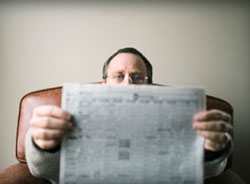Eyes Over 40
 As people reach their 40's, a condition called presbyopia will occur. Presbyopia is the inability to focus on objects at a close distance. An easy way to think about it is to realize as we age our "autofocus" mechanism decreases.
As people reach their 40's, a condition called presbyopia will occur. Presbyopia is the inability to focus on objects at a close distance. An easy way to think about it is to realize as we age our "autofocus" mechanism decreases.
One usually notices that it is harder to read or use the computer. Wearing bifocals, progressive lenses, or reading glasses is a common way to remedy this condition.
Presbyopia is a natural consequence of the aging process. There is no cure, though researchers are constantly looking for one. Even if a person has never had vision problems before, he or she can still develop presbyopia. While symptoms can present suddenly, presbyopia usually occurs over a long period of time. Symptoms include having to hold things at arm’s length to see them clearly, eye strain, fatigue and headaches from near work.
Computer Glasses
To reduce eye strain and fatigue while using the computer, we carry specialized computer lenses. These lenses are perfect for computer users who spend a majority of their days working on computers. And since three out of four computer users will suffer from Computer Vision Syndrome, computer lenses are a great way to keep your eyesight healthy.
Recommended Link:
All About Vision: Computer Glasses
Reading Glasses
One of the first areas of your life where presbyopia becomes prominent is in your ability to read. There are a variety of styles of reading glasses available, with sleek designs that allow you to carry them anywhere.
Recommended Link:
All About Vision: Reading Glasses
No-Line Bifocals
For many presbyopes, bifocal lenses are a necessity. But it can be difficult to adjust to the harsh line that is found in bifocal lenses. Fortunately, there are no-line lenses, which are also called progressive lenses. No more lines! Just a gradual change in focusing power which allows you to comfortably focus on any distance. Just as in wearing bifocals, distant objects are viewed through the top portion of the lenses, and near objects are viewed through the bottom portion of the lenses.
Recommended Link:
All About Vision: Bifocals
Bifocal Contacts
If you need bifocals but prefer not to wear glasses, you may want to try bifocal contact lenses. In this way, you can have all of the benefits of progressive eyeglasses in the convenience of contact lenses. Talk with Drs. Hansen, Pietigs, or Seelye about bifocal contacts today.
Recommended Link:
All About Vision: Bifocal Contacts
Monovision Correction
For some of our emerging presbyopes we offer another option to glasses, monovision contact lenses. This is a method of fitting your dominant eye for distance vision and your non-dominant eye for near vision. Contacts are available in disposable, extended wear, and even daily disposable lenses to fit your lifestyle. Most patients require 2-4 weeks to make the adjustment from binocular vision to monovision.
Recommended Link:
All About Vision: Monovision
